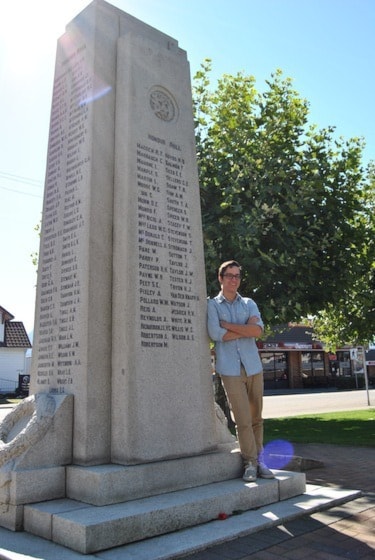Soldiers from Chilliwack who laid down their lives in the Great War and Second World War can now be searched online with interactive maps.
Welcome to the Poppy Project.
The research was undertaken by history major Pierce Smith, as part of a UFV work study program.
"For people today, the Poppy Maps create a connection, through geography and history, into the past," writes Smith in his online introduction. "In this way, we can be linked to the lives of those who sacrificed themselves in two world wars that had such an impact on Canadians in the 20th century."
He started with the 108 names listed on the cenotaph. He spent months tracking down modern-day addresses of those listed on the Chilliwack War Memorial behind the Chilliwack Museum.
Most of the soldiers lived in Chilliwack before shipping out, but some did not.
"Therefore, it is important to keep in mind that some of the names on the Memorial will not appear on the map, because there is no historical record of their presence in Chilliwack," Smith cautioned.
Using everything from Progress newspaper articles, tax rolls, census data, maps, attestation papers and burial records, Smith plotted out where they lived, and corresponded those locations with current street addresses as best he could.
The Poppy Project built upon previous research on Chilliwack's War Memorial undertaken by Paul Ferguson, accessible on the Chilliwack War Memorial website as well as in the Paul Ferguson files at the Chilliwack Archives. This website was created by the Chilliwack Museum and Archives, the embedded Google map will be maintained by the UFV history department.
Several of the actual addresses changed over the decades, as property lots were subdivided into smaller lots, and house addresses changed from 1914 and 1939. But since legal property descriptions of yesteryear can be traced to property descriptions today, even if subdivided into smaller lots, the property area where Chilliwack’s soldiers lived was the same.
The unique Chilliwack project links the past with the present with the help of technology, and the timing for Remembrance Day coming up, is perfect.
"It brings home the reality of local people who were part of this great national trauma, and locates it on the streets that we ourselves inhabit," UFV professor Molly Ungar, who was Smith's project supervisor.
She gave the example of Private Orville Hubert Boucher of Chilliwack, who lived with his parents at the corner of Brooks Avenue and Elm Drive. He enlisted in February of 1916 and was killed during the Battle of Hill 70, in August of 1917.
The maps are at: www.chilliwackmuseum.ca/poppy-project/
